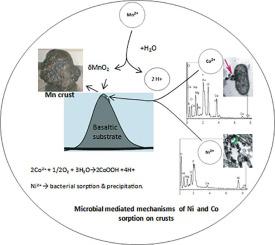Ore Geology Reviews ( IF 3.3 ) Pub Date : 2021-09-03 , DOI: 10.1016/j.oregeorev.2021.104458 P.P. Sujith 1, 2 , Maria Judith B.D. Gonsalves 1

|
Bacterial participation in the formation of ferromanganese (Fe-Mn) mineral deposits is highly debated, as the precipitation of metals could occur by both chemical and biologically mediated mechanisms. Besides, the enrichment of trace metals like Co and Ni in Fe-Mn deposits is further complicated by the aging process of the crust, scavenging by the Fe-Mn oxide surfaces and co-precipitation by bacterial activity. The concentration of Co in Fe-Mn crusts varies from 0.1 to 1.9% and Ni from 0.2 to 1.1% in individual bulk crusts implying marked heterogeneity in their composition. Several reviews address different aspects like the molecular mechanisms of Co and Ni uptake in bacteria, enzymes containing Ni and Co and their relative toxicity. Nonetheless, only limited data are available on the interactions of Co and Ni with bacteria and how they contribute to the enrichment of these metals in the deep-sea mineral deposits. Hence, this review focuses on the geochemical and microbiological perspective of the interactions of Co and Ni, different modes of their enrichment and requirement for several physiological and biogeochemical processes in bacteria. The detailed survey of the studies indicates that both chemical and biological mechanisms promote the accretion and dissolution of minerals with bacteria accelerating the net oxidation–reduction reactions in their directions. Combined geochemical and microbiological interactions in conjunction with detailed molecular analysis would further confine processes affecting Fe-Mn mineral formation.
中文翻译:

氧化锰铁矿床:钴和镍相互作用的地球化学和微生物学观点
细菌参与铁锰 (Fe-Mn) 矿床的形成备受争议,因为金属的沉淀可能通过化学和生物介导机制发生。此外,随着地壳老化过程、Fe-Mn氧化物表面的清除和细菌活动的共沉淀,Fe-Mn矿床中Co和Ni等痕量金属的富集进一步复杂化。Fe-Mn 结壳中 Co 的浓度在 0.1% 到 1.9% 之间变化,Ni 在单个块状结壳中的浓度从 0.2% 到 1.1% 不等,这意味着它们的成分存在明显的不均匀性。一些评论涉及不同的方面,如细菌吸收 Co 和 Ni 的分子机制、含 Ni 和 Co 的酶及其相对毒性。尽管如此,关于 Co 和 Ni 与细菌的相互作用以及它们如何促进深海矿床中这些金属的富集,只有有限的数据可用。因此,本综述重点关注 Co 和 Ni 相互作用的地球化学和微生物学视角、它们的不同富集模式以及细菌中几种生理和生物地球化学过程的需求。对研究的详细调查表明,化学和生物机制都促进了矿物质的吸积和溶解,细菌加速了它们方向上的净氧化还原反应。结合地球化学和微生物相互作用以及详细的分子分析将进一步限制影响铁锰矿物形成的过程。



























 京公网安备 11010802027423号
京公网安备 11010802027423号